In the human quest for knowledge of extraterrestrial life, Mars has always loomed large as an otherworldly symbol. Named after the Roman god of war, this celestial body is evocative of alien exploration. Science fiction fans and astronomers alike have long taken a keen interest in Mars as one of our closest neighbors. But just how far away is Mars from Earth, the Sun, and the other planets in our solar system? Read on to find out this and much more about the Red Planet!
How Far Away is Mars?
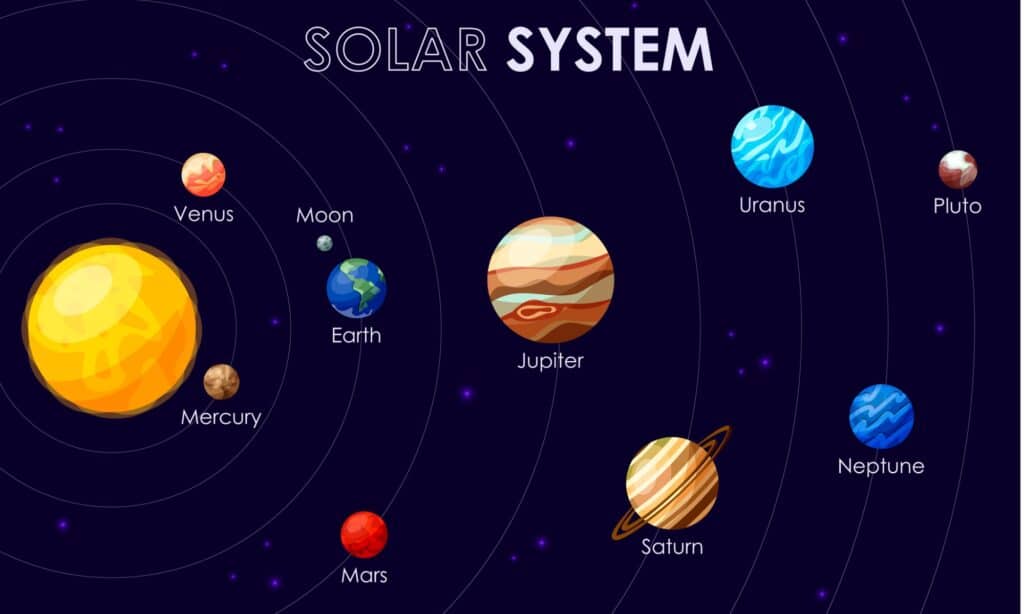
Mars is 140 million miles from Earth and 143 million miles from the Sun.
©iStock.com/Alexander Timoshin
On average, Mars lies 140 million miles from Earth and 143 million miles from the Sun. It’s the fourth planet in our solar system after Mercury, Venus, and Earth. Its distance from the Sun and fellow planets constantly changes according to where each planet is in its orbit.
Mars’ orbit is elliptical (the shape of an oval). This elliptical orbit brings it closer to the Sun and other planets at certain points. The term aphelion refers to the maximum distance a planet can be from the Sun. The term perihelion refers to its minimum distance.
Distance From the Sun to Mars: 143 Million Miles
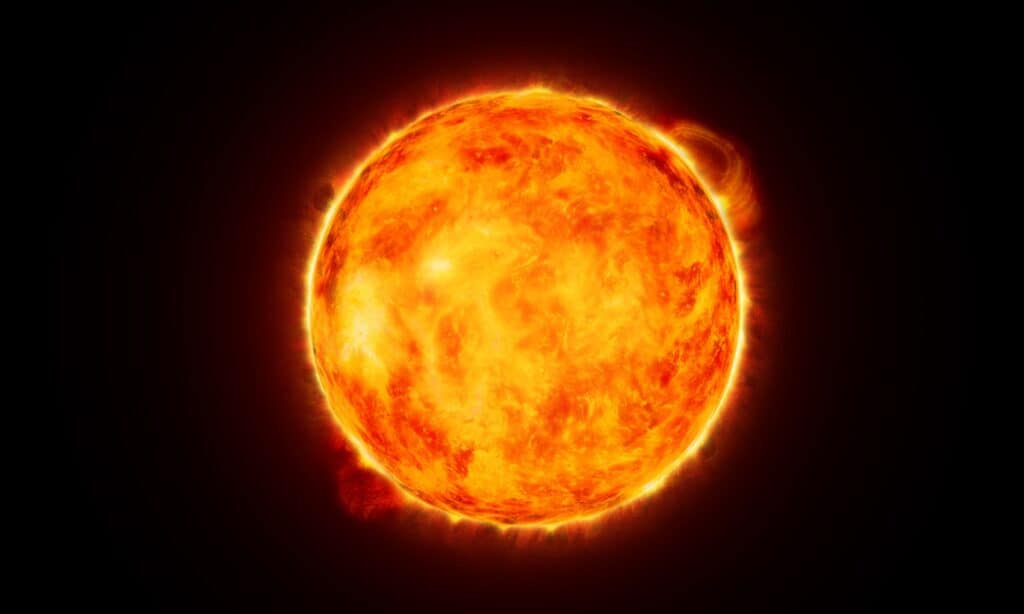
Mars is 143 million miles from the Sun.
©iStock.com/hadzi3
On average, Mars is 143 million miles from the Sun. Its aphelion is 154.85 million miles, while its perihelion is 128.43 million miles.
There are other ways to measure distance. A light year refers to the distance light travels in one Earth year. Mars is approximately 0.000024155306893301653 light years from the Sun. This means that, on average, light from the Sun takes about 12 minutes and 40 seconds to reach it.
Astronomers also measure distance in AUs, or astronomical units. One astronomical unit is the average distance from the Earth to the Sun, about 93 million miles. Mars is 1.52 AUs from the Sun.
Distance From Earth to Mars: 140 Million Miles
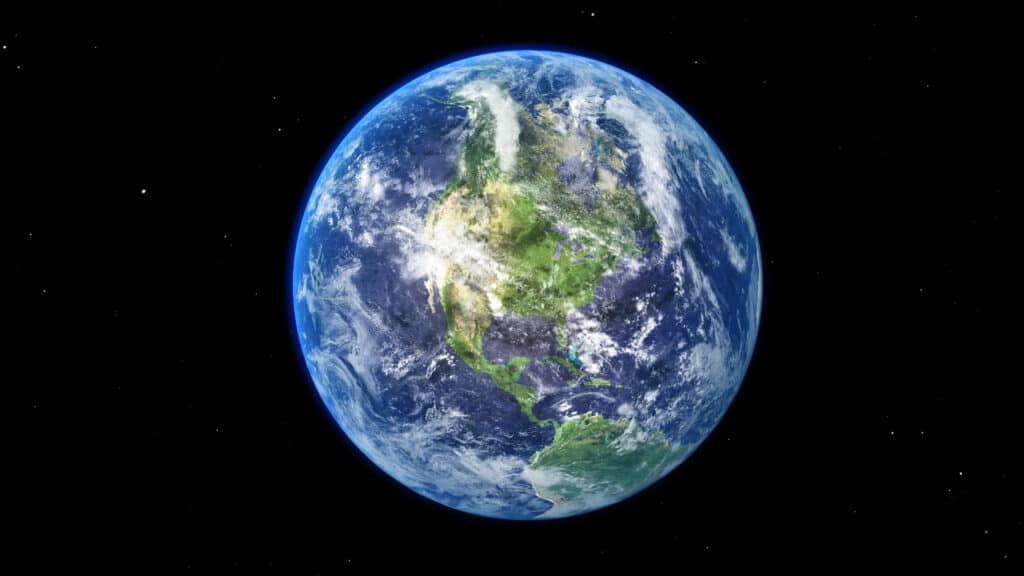
Earth is 140 million miles away from Mars on average.
©iStock.com/Thaweesak Saengngoen
Earth is 140 million miles away from Mars on average. Expressed another way, these two planets are 0.52 AUs apart. The maximum distance between them is 249.1 million miles, while the minimum distance is 33.9 million miles. Of all the planets in our solar system, Mars is the most similar to ours in terms of soil composition as well as its core, mantle, and crust.
Distance From Mercury to Mars: 105.65 Million Miles

Mars and Mercury stand an average of 105.65 million miles apart.
©iStock.com/FlashMyPixel
Mars and Mercury stand an average of 105.65 million miles apart, or 1.14 AUs. Mercury is the closest planet to the Sun and is therefore much hotter than Mars, with a mean temperature of 333 °F (176 °C). It only takes Mercury 88 days to orbit the Sun. Unlike Mars, which has 2 moons, Mercury has none.
Distance From Venus to Mars: 74.4 Million Miles
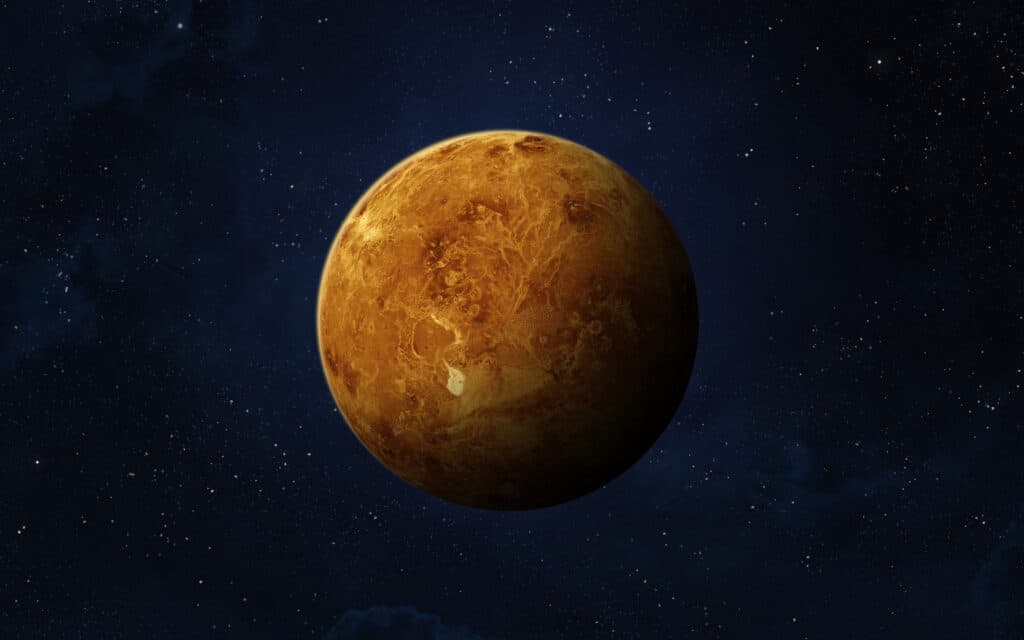
Venus stands apart from Mars by 74.4 million miles.
©iStock.com/buradaki
As the second-closest planet to the Sun, Venus stands apart from Mars by 74.4 million miles. This comes to 0.8 AUs. They are both terrestrial planets with similarities to Earth. In fact, Earth and Venus share the nickname “twin planets” for their similar density, mass, and size. Venus appears so bright from Earth because light easily reflects off the acidic crystals in its cloudy atmosphere.
Distance From Jupiter to Mars: 342 Million Miles
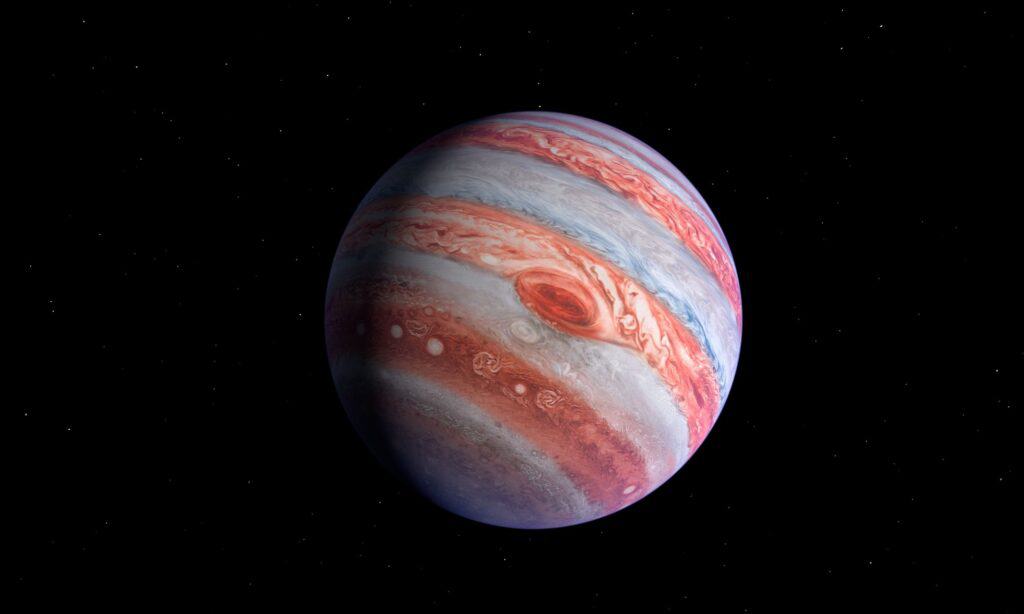
Mars is 342 million miles from Jupiter, the largest planet in our solar system.
©joshimerbin/Shutterstock.com
Mars sits about 342 million miles from Jupiter, or 3.68 AUs. Jupiter is the first of the four outer planets in the solar system. It’s also the largest planet orbiting our Sun, equal in mass to over 300 Earths. Mars may be so relatively small because Jupiter’s gravitational field interfered with its formation. Jupiter is famous for its Great Red Spot, a massive storm 10,000 miles across.
Distance From Saturn to Mars: 743.6 Million Miles

The distance from Mars to Saturn is approximately 743.6 million miles.
©iStock.com/Elen11
The distance from Mars to Saturn is approximately 743.6 million miles, or 7.99 AUs. Saturn has a rocky core with an extensive gaseous atmosphere. It’s the second-largest planet in our solar system, with a diameter of 72,400 miles, ten times that of Earth. Most notable are its seven rings, composed of debris from comets, asteroids, and moons.
Distance From Uranus to Mars: 1.64 Billion Miles

Mars is 1.64 billion miles from Uranus.
©iStock.com/IncrediVFX
Mars is 1.64 billion miles from Uranus, or 17.69 AUs. In contrast to the 4 terrestrial planets, Uranus is a gas giant like Jupiter, Saturn, and Neptune. It appears bluish-green to observers because the methane in its atmosphere absorbs red light. The third-largest planet in the solar system, Uranus, is extremely windy, with temperatures as low as -353 °F (-214 °C).
Distance From Neptune to Mars: 2.66 Billion Miles

Mars is 2.66 billion miles from Neptune, the furthest planet in our solar system from the Sun.
©iStock.com/3quarks
Neptune stands a whopping 2.66 billion miles from Mars, or 28.56 AUs. It’s even colder than Uranus, measuring -373 °F (-225 °C) on average. As the eighth planet, it’s the furthest from the Sun and the fourth-largest in diameter. Much like Uranus, Neptune appears blue because methane in its atmosphere absorbs red light.
How Long Does It Take to Travel to Mars From Earth?
It takes about 7-9 months to travel to Mars from Earth, depending on where the two planets are in their orbits. This makes human travel to the Red Planet prohibitive. The resources and advanced life support systems needed to successfully transport humans to another planet are beyond current technological capabilities. This doesn’t mean scientists have given up; on the contrary, plans to land a human on Mars within the next couple of decades are in the works.
Can Humans See the Red Planet From Earth?
When Mars is nearest to Earth in its orbit, called the Mars Close Approach, it is possible to see it at night with either a telescope or the naked eye. It appears at its brightest every 15-17 years, but only once or twice during this time span.
Has Anyone Ever Set Foot on Mars?
To date, no human has ever set foot on Mars. However, several unmanned probes have landed on the Red Planet over the past few decades. The first spacecraft to reach it was NASA’s Mariner 4 on July 14, 1965. It passed by, taking the first close-up photos of the planet. The first craft to ever land on Mars was Viking 1, belonging to NASA’s Viking Project. The lander touched down on July 20, 1976. A second craft, Viking 2, also successfully landed around the same time.
The most recent craft to land on Mars is NASA’s 2020 Perseverance Rover, landing on February 18, 2021. Its task is to discover evidence of past life on Mars.
Martian Climate and Lifeforms
Mars is a cold planet with an average temperature of -81 °F (-62.7 °C). However, it can get as cold as -220 °F (-140 °C) or as hot as 70 °F (21.1 °C). The planet is desert-like, with polar ice caps at both poles. Its surface is pitted with canyons, craters, volcanoes, and dry lake beds with a crust primarily made of volcanic basalt rock. Dust storms are frequent. A thin atmosphere composed mostly of carbon dioxide also means high exposure to radiation. Its year lasts 687 days, or 1.88 Earth years. One Martian day lasts about 40 minutes longer than an Earth day.
There is no evidence that life ever existed on Mars or that it exists today, though the planet may once have been more hospitable with liquid water and warmer temperatures. The search for the presence of microorganisms continues.
Martian Soil and Composition
Mars bears the nickname “the Red Planet” because of its soil. The soil contains iron minerals, which oxidize (rust). The rust is what gives the planet its reddish look. Patches of green also occur on its surface, though scientists are not sure what causes this, as it isn’t vegetation. Its crust contains many elements, including silicon, oxygen, iron, magnesium, aluminum, calcium, and potassium. The core is made of iron and nickel.
Is There Water on Mars?
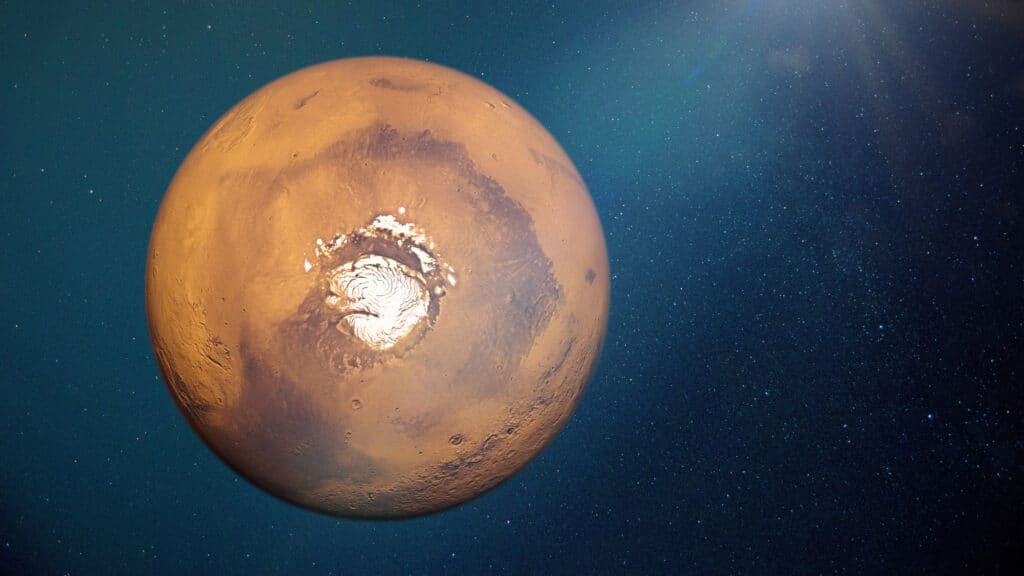
While water cannot exist on Mars, there is a vast amount of ice that’s several miles thick in some places.
©iStock.com/dottedhippo
Because of the low pressure and low temperatures, water can’t exist in liquid form on Mars. Any liquid water would either freeze or boil away due to the low pressure. This wasn’t always the case. Hundreds of millions of years ago, it appeared that liquid water did exist on the Red Planet. Since then, the planet has dried up, with water taking either solid or gaseous form. However, a vast amount of ice comprises Mars’ polar ice caps, resembling Earth’s Arctic and Antarctic regions. The ice is several miles thick in places.
Could Humans Live On Other Planets?
Humans could only live on Mars in artificial habitats. Unaided survival is impossible due to a number of factors, including:
- Freezing
- High radiation due to the thin atmosphere
- Unbreathable atmosphere
- Lack of vegetation
- Absence of liquid water
- Low gravity
Scientists are divided on the viability of human habitation on Mars. Right now, all agree that it’s impossible. However, some are optimistic about the future, like planetary scientist Jesse Tarnas. He believes it’s just a matter of time before technology allows us to create viable habitats on other planets, allowing humans to learn more responsible ways of inhabiting Earth. Colonization would require using every resource to its fullest and avoiding waste. NASA chief scientist Jim Green suggests it may only be a couple of decades before the first human sets foot on Mars, with many hopes set on the year 2040.
So how far away is Mars? Though the distance remains the same, we’re getting better and better at crossing the divide – and one day, we just might go there ourselves!
Check out this article on “How Much You’d Weigh On Mars.”
The photo featured at the top of this post is © iStock.com/buradaki
Thank you for reading! Have some feedback for us? Contact the AZ Animals editorial team.







